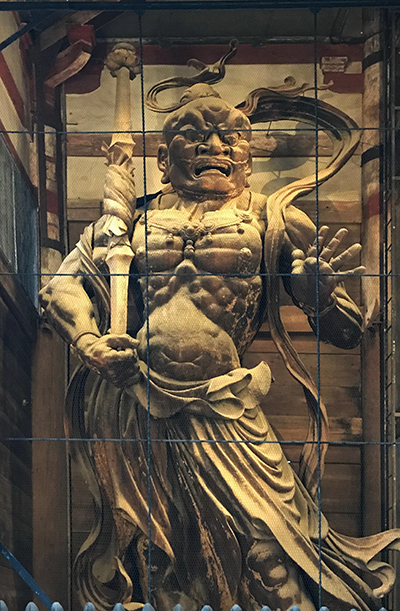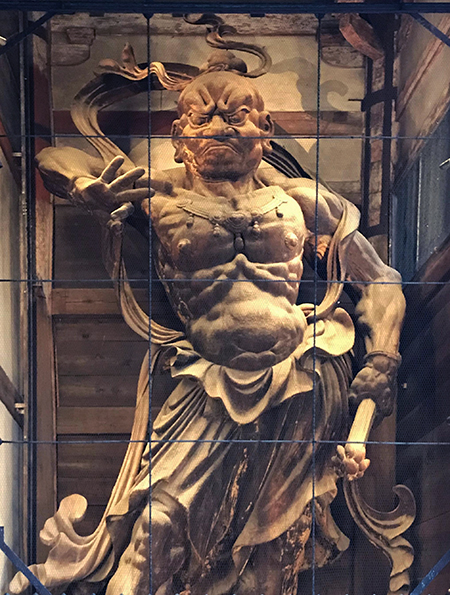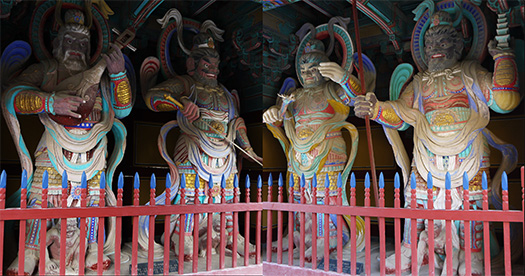


東大寺南大門といえば金剛力士立像であります。
南大門は平安時代の962年に台風で倒壊した後、
源平争乱期1181年に平重衛の南都焼討によって多くの堂塔を失ってしまった。
多くの僧俗の南都復興の声に応えた僧・重源さんの勧進活動によって
頼朝の支援を得るなどして鎌倉時代の1199年に大仏様式を採用して復興された。
そして内部の金剛力士立像は右に吽形、左に阿形を安置。
これは一般的な阿形と吽形の配置の左右逆に安置されていると言われる。
で、重源さんの復興プロジェクトチームから制作を依頼された彫師・運慶が
鎌倉ルネサンスとも思えるリアリズムの最高傑作を制作した。
日本史の教科書で登場する彫刻の最たる表現であり、子どもたちが
建築を装飾する彫像として教科書で見る最高のものではないかと思います。
わたしもはじめて写真を見たときから圧倒されていた。
同じように美術教育で学習する西洋のルネサンスを代表するような
ミケランジェロ彫刻に対して、そのはるか250年以上前の日本鎌倉期に
このような力感に満ちたリアリズム芸術を育んでいた日本社会に驚愕させられた。
わたしたちの国と社会に対して深い尊崇の念を抱かせる運慶の仕事、
そしてそれを支えた僧・重源さんのプロデュース力を思い知らされる。
南大門はこの鎌倉期の修復に先立つ700年代後半期建造であり、
そのときにどのような彫像が置かれていたかどうか、不明だけれど
マザーになるテーマ彫像はあったのではないかと想像しています。
阿吽の形相を見せる彫像が置かれていたに違いないと思うのです。
神社建築での「狛犬」表現と似たテーマ性であったに相違ない。
一方、写真3枚目には先般紹介の韓国仏国寺の山門内部の彫像。
これは朝鮮総督府時代の再建当時に奉納された日本人彫刻家による彫像で
テーマも「四天王像」という中国的な画題が選定されている。
仏国寺創建期の彫像とテーマは同じだろうと想定できる。
これらは700年代後半期という同時代創建期の日朝の文化相違なのではないか。
この彫刻についてはそれぞれ過去にもブログで触れましたが
日本の金剛力士テーマと韓国朝鮮のギター弾き彫像という対比は面白い。
どちらも世界遺産として民族性を表現していると考えるとなおさら。
ひとつの考えとしては西洋ルネッサンスと同質性の高い日本と
中国文化への帰依がより強く感じられる韓国朝鮮の明瞭な相違といえるかも。
この鎌倉期の東大寺再建の落慶法要では
日本史上最初の武権成立を背景に、戒厳令状態で頼朝が参詣したとも伝わる。
平家の残党、義経勢力の残存という政治軍事情勢もあっただろうけれど、
この金剛力士像を頼朝の武権はどのように認識したか、
日本史の一断面としてその光景を脳裏に浮かばせることがよくあります。
English version⬇
[Unkei Nio Statue and Bulguksa Temple / Four Tenno Statues “Awoyiyoshi” Todaiji Temple Review-2]
Speaking of Todaiji Nandaimon, it is the statue of King Nio.
After the Namdaemun collapsed in 962 during the Heian period due to a typhoon,
In 1181 during the Genpei War, many temples were lost due to the Siege of Nara by Taira no Shigehira.
By the promotion activities of the monk, Chogen, who responded to the voices of many monks’ reconstruction of the southern capital
It was reconstructed in 1199 during the Kamakura period by adopting the Great Buddha style with the support of Yoritomo.
And the statue of King Nio inside is enshrined in A-un on the right and A-un on the left.
It is said that this is placed upside down in the general A-un and A-un arrangements.
Then, Unkei, a tattooist who was asked to produce by Mr. Shigegen’s reconstruction project team
I created the best masterpiece of realism that seems to be the Kamakura Renaissance.
It is the most important expression of sculpture that appears in Japanese history textbooks, and children
I think it is the best statue you can see in a textbook as a statue to decorate architecture.
I was overwhelmed when I first saw the photos.
Similar to the Western Renaissance studying in art education
For Michelangelo sculpture, more than 250 years ago in the Kamakura period in Japan
I was amazed by the Japanese society that nurtured such powerful realism art.
Unkei’s work, which gives us deep reverence for our country and society
And I am reminded of the producing power of the monk, Chogen, who supported it.
Namdaemun was built in the late 700s prior to the restoration of the Kamakura period.
I don’t know what kind of statue was placed at that time.
I imagine that there might have been a theme statue that would become a mother.
I think there must have been a statue showing the appearance of Aun.
It must have been a theme similar to the expression “Komainu” in shrine architecture.
On the other hand, the third photo is a statue inside the gate of the Bulguksa Temple in Korea, which was introduced recently.
This is a statue by a Japanese sculptor dedicated at the time of reconstruction during the Government-General of Korea.
As for the theme, a Chinese theme called “Four Tenno Statues” has been selected.
Perhaps it is a cultural difference between Japan and Korea, which was founded in the latter half of the 700s.
I mentioned these sculptures in my blog in the past
The contrast between the Japanese Nio theme and the Korean guitar-playing statue is interesting.
Especially when considering that both express ethnicity as a World Heritage Site.
One idea is that Japan has a high homogeneity with the Western Renaissance.
It may be said that it is a clear difference between South Korea and Korea, where the devotion to Chinese culture is felt more strongly.
In this memorial service for the reconstruction of Todaiji Temple during the Kamakura period
It is also reported that Yoritomo worshiped under martial law against the backdrop of the establishment of the first military power in Japanese history.
There may have been a political situation in which the remnants of the Heike clan and the Yoshitsune power remained,
How did Yoritomo’s military power recognize this statue of Nio?
It often comes to mind as a cross section of Japanese history.
Posted on 9月 28th, 2021 by 三木 奎吾
Filed under: 住宅マーケティング, 日本社会・文化研究







コメントを投稿
「※誹謗中傷や、悪意のある書き込み、営利目的などのコメントを防ぐために、投稿された全てのコメントは一時的に保留されますのでご了承ください。」
You must be logged in to post a comment.